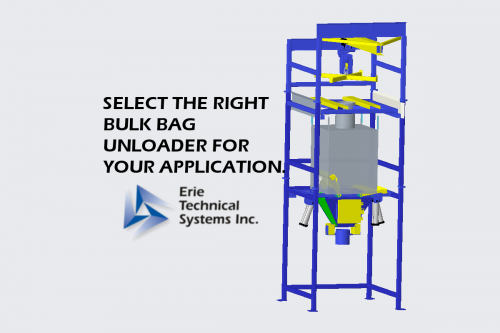The purpose of a bulk bag unloader is to allow operators to unload bulk materials received in bulk bags both safely and quickly. A bulk bag unloader consists of a support frame, a lifting frame and outlet support at a minimum with optional components added based on the application. This article will discuss what to consider before purchasing a bulk bag unloader. For information on the cost of bulk bag unloaders please see our other article “How much does a bulk bag unloader cost?”
Number 1 – Think about height
There are three “heights” to consider when selecting a bulk bag unloader: the height of the bulk bag, the required height of discharge and the available ceiling height.
Bag Height - Bulk bags can be constructed in virtually any size but the most common types of bags for shipping of bulk materials have horizontal dimensions in the range of 40 to 48” square (1016 to 1219 mm square). This standard range allows for packing of the bulk bags side-by-side on a typical semi-trailer. Most bulk bag unloaders are designed to accommodate bags of this width and depth. The height of the bags can vary widely from 40” up to 60” or even 75”. It is important to consider all the possible bulk bag heights to be unloaded to ensure that the frame is adjustable over the full range.
Discharge Height – The discharge height is the minimum amount of space needed under the outlet of the bulk bag. From this point the material can drop directly into another piece of equipment or be transferred at an angle with a chute horizontally, or at an angle upwards with a conveyor.
Ceiling Height – The ceiling height is often overlooked initially when considering a bulk bag unloader. For units with a lifting hoist, the support beam must be added to the height of the support frame. For units with a forklift support, the additional height of the forklift mast should be considered to avoid damage to the roof when loading the bulk bags.
Number 2 – Think about weight
The weight of the bags to be unloaded determines the size of the structural steel for the frame as well as the size and cost of the electric hoist and trolley, if equipped. Bulk bag weights can vary widely based on product density and bulk bag size, but bulk bag unloaders are generally designed for either a 2,000# load (4,409kg) or a 4,000# load (8818 kg). The main difference in the structure of the frame is the size and thickness ofthe square tube used for frame construction. A 2,000# bulk bag unloader will generally be constructed of 3 x 3 square steel tube while a 4,000# frame will be constructed from 4 x 4 square steel tube.
Number 3 – Think about the product
The product that is being unloaded can dictate many of the features included in a bulk bag unloader. Additional considerations must be made for materials that are non-free-flowing, hazardous or corrosive materials.
Non-Free-Flowing Materials – Free-flowing materials require little additional features in a bulk bag unloader, but sticky materials or materials that tend to pack during shipment require features such as flexor paddles or vibration to aid in extracting the material from the bulk bag. Dusty powders require the use of pinch rings or an enclosed untie-box with a door to limit operator exposure and reduce spillage.
Hazardous Materials – Materials that are dusty, toxic or flammable will require additional considerations for personnel safety. Dust collection systems can be added to draw material away from the operator and sealed untie boxes can be used to limit exposure when product is flowing. Applications for flammable materials will require the use of explosion-proof hardware and hoists in the bulk bag unloader.
Corrosive Materials – The standard material for bulk bag unloaders is carbon steel that is coated with primer and industrial enamel paint. Carbon steel is used for its low cost and high strength. For applications where corrosion is an issue, bulk bag unloading frames and components should be constructed of 304 or 316 series stainless steel.
Number 4 – Think about the process and the operator
A good exercise is to walk through the process of loading and removing a bulk bag and how the operator interacts with the equipment.
Loading/Removal– The process starts with the operator attaching the bulk bag to a lifting frame. This can be a forklift style or hoist style frame. A forklift style is quick to load but ties up a forklift for the duration of the lift. The hoist style lift has the added cost of the hoist but does not tie up the forklift. For units equipped with a hoist and trolley, the speed of the chain hoist is an often-overlooked factor that determines the rate at which bags can be unloaded.
Untying – For bags with an outlet spout, the operator will untie the outlet spout to start the product flow. The height relative to the operator should be reviewed to ensure a comfortable working height. An elevated work platform or ladder may be required.
Re-tying – The ability to re-tie a partially empty bulk bag requires the addition of a valve that can close the bag outlet spout. The type of valve depends on whether the flow needs to be shut off under static or flowing conditions. Closing of the outlet of a bulk bag under static conditions requires significant force and specialized v-form valve. Once the valve is closed, the bag spout can be re-tied and removed partially empty.
Transfer – Once the material is in the bulk bag unloader, it will need to be transferred out to some other process or piece of equipment. A simple straight or angled outlet chute can be used to discharge directly below the unloader. A vibratory conveyor can move product horizontally to other equipment. A flexible screw conveyor or vibratory spiral elevator can be used where the material must be elevated to reach above the discharge height.
Operator Safety – In addition to protecting the operator from fatigue and hazardous materials, consideration should be given to the proper lifting, stacking and handling of bulk bags. Before beginning any work with bulk bags it is a good idea to review the proper handling techniques and practices published by FIBCA (Flexible Intermediate Bulk Container Association) – “FIBC Handling Guidelines”.
These are a few items to consider when searching for the right bulk bag unloader. For additional help and guidance, please call us today at 814-899-2103 or email us at info@bulkfilling.com.
Again, for information on the cost of bulk bag unloaders please see our other article “How much does a bulk bag unloader cost?”

